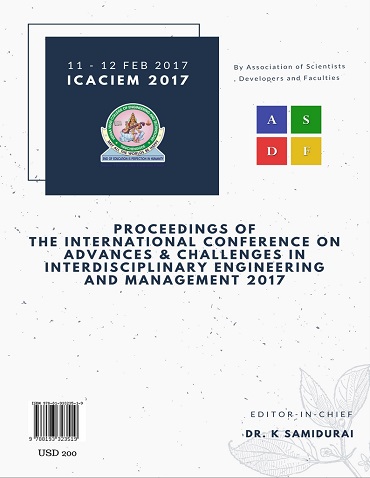- Publication Meta:Value
- Short Title:ICACIEM 2017
- Publisher:ASDF, India
- ISBN 13:978-81-933235-1-9
- ISBN 10:81-933235-1-3
- Language:English
- Type:Hard Bound - Printed Book
- Copyrights:ICACIEM Organizers / DCRC, London, UK
- Editor-in-Chief:Dr K Samidurai
- Conference Dates:11 - 12, February 2017
- Venue Country:Tiruchengode, India
- Submitted Papers:589
- Acceptance Rate:8.12%
- Website:www.icaciem.org
Welcome to ASDF Electronic Digital Library!
ICACIEM 2017
ICACIEM 2017
International Conference on Advances & Challenges in Interdisciplinary Engineering and Management 2017
Paper 129
Active Content Delivery Using Live Localization Scheme in Wireless Network
M Manikandan1, M Jayaprakash2
1,2Associate Professor, Vidyaa Vikas College of Engineering and Technology, Tiruchengode, India
Abstract
This paper proposed the efficient distribution of live and scheduled multimedia content to mobile users via a ubiquitous wireless Internet. The objective is to design and develop a dynamic content delivery system that (1) enables content owners to deliver their multimedia content to a large number of heterogeneous receivers, and (2) enables receivers to continuously receive that content, independent of their location and the network they connect to. Previous investigations into this topic have shown that multimedia content can be efficiently distributed through an overlay network that consists of multiple distributed proxy servers. In this paper, we extend this concept to the distribution of live and scheduled multimedia content through multiple aggregators. An aggregator is an intermediary content provider that aggregates live multimedia content from various content sources and delivers it to mobile users through a pool of proxy servers. The availability of the same content through multiple aggregators enables mobile users to switch from one aggregator to another, thus alternately receiving the same content from different aggregators. The service area of an aggregator may be restricted to a certain set of networks, in which case switching to such an aggregator also requires mobile hosts to handoff to a network that is part of the aggregator’s service area. To support roaming users, aggregators establish application-level roaming agreements between each other. These agreements enable users to receive channels from multiple aggregators while having a subscription with only a few of them. The system transparently switches mobile hosts from one aggregator to another and executes handoffs on the mobile host’s network interfaces. The system switches a mobile host to the aggregator that provides a certain channel in the best configuration, where ‘best’ is defined by the preferences of the end-user. Our analysis consists of two parts: (1) a heuristic analysis of the application and network-level delay components involved in a typical switch and an estimation of their best-case values, and (2) an empirical analysis of the delay introduced by SIP transactions under various 802.11 network conditions. The analysis shows that the Live Localization Scheme (LLS) usually experiences little delay, except at the very edge of an 802.11 cell. Based on our implementation and measurement work, we conclude that the LLS System is a feasible system that provides a clear contribution to the multimedia-everywhere vision.
Keywords
Author's Profile
Author profile can be generated and linked through our partners World Book of Researchers. To include your profile online Click Here. After it is approved, please email to edlib @ asdf.res.in to create a link with all the papers.
e-AID
ICACIEM.2017.129
Cite this Article as Follows
M Manikandan, M Jayaprakash. Active Content Delivery Using Live Localization Scheme in Wireless Network. International Conference on Advances & Challenges in Interdisciplinary Engineering and Management (2017): 65. Print.
© 2010 - by EDLIB .
All Rights Reserved.

